As Veterans Day fast approaches, it's important to take the time and reflect on the significance of this observance to honor the brave servicemembers who've answered the call of duty. Let's take a closer look at the history of this federal holiday before diving into some ways you can participate.
From Armistice to Veterans Day
The first Veterans Day was celebrated on November 11, 1919 — however, the holiday didn't always go by that name. Following the end of the first World War, President Wilson commemorated the 11th day of the 11th month as Armistice Day; but it wasn't until 1926 that the United States Congress officially recognized the holiday.
After World War II, President Eisenhower issued the first Veterans Day Proclamation, both renaming the observance and shifting its focus to honor all of our nation's veterans.
How To Observe Veterans Day and Honor Our Nation's Heroes
Whether you have a servicemember in your life or you're looking for more ways to show your gratitude this Veterans Day, here are a few ideas to honor our veterans:
1. Take a Moment of Silence
Each year on Veterans Day, there are two minutes set aside for a moment of silence to honor those who have served and their family members at 2:11 PM EST.
2. Extend Your Gratitude
If you know a veteran or meet one, don't forget to thank them for their service. Even this simple expression of appreciation can have a huge impact.
3. Send a Letter or Care Package
Consider sending a personal letter and care package to our servicemembers. Who doesn't appreciate a nice note and fun treats every once in a while, especially while you're away from home?
4. Assist a Veteran You Know
If you have a veteran in your life, be sure to check in with them and see if there's anything you can help them with.
5. Support Military Families in Need
Even if you don't know a military family personally, there are plenty of organizations, like Soldiers' Angels, that allow you to lend a helping hand to families in need.
6. Help Unhoused Vets
Nobody deserves to live on the streets, but especially those who have served our country. Contributing your time or money to organizations like U.S. Vets can go a long way in helping unhoused veterans get back on their feet with a roof over their heads.
7. Make a Donation
If you're feeling generous, consider making a donation to any number of veteran organizations. For example, Disabled American Veterans (DAV) is a great nonprofit offering life-changing support to our nation's heroes.
8. Volunteer Your Time
In addition to U.S. Vets and DAV, there are countless other nonprofits and charities that are in need of helping hands. Volunteering your time at these organizations can be a great way to give back and serve those who have already served.
9. Support Veteran-Owned Businesses
Beyond helping veterans through charity organizations, you can also lend your support to businesses owned by servicemembers. Whether it's a local store or a national brand, providing this economic support is crucial to keep these businesses thriving.
10. Visit a Veteran Memorial
Finally, you can pay your respects to the brave servicemembers who gave the ultimate sacrifice by visiting a local or national veterans' memorial. Feel free to leave a small token of your respect in a fountain or on a gravestone, and consider donating if the memorial has the option.
While our list stops there, that doesn't mean yours should! Don't be afraid to get involved with your local community and find out more ways you can help give back to our nation's heroes.
October 26th marks National Day of the Deployed — an observance created by the organization Soldier's Angels to honor the heroic men and women currently deployed. In other words, it's a day to say "Thank you" for all the sacrifices our active duty servicemembers and their families make in the name of our country.
Of course, this gratitude can extend beyond words to actions, such as sending a care package or volunteering to help out veterans and military families. But before we dive into ways you can support our deployed soldiers, let's first understand why we celebrate the Day of the Deployed.
The history behind the Day of the Deployed
First celebrated in 2006 — when the group Soldiers' Angels approached then-Governor of North Dakota, John Hoeven, to proclaim the day as a time to honor active-duty servicemembers — the Day of the Deployed is a relatively new holiday. However, this was only the start, as, by 2010, the movement to recognize October 26th as the Day of the Deployed had grown to 40 states.
In 2011, Hoeven, who was then a Senator, sponsored a unanimously agreed-upon resolution to designate October 26 as an official national holiday, which is now observed by all 50 states.
But how can you participate in the Day of the Deployed?
Observing the Day of the Deployed
When our troops are deployed, they must leave behind their families, their homes, and almost everything that's familiar to them in service to their country. These significant sacrifices warrant recognition.
Here are a few ways you can give back to those who are currently deployed and their families:
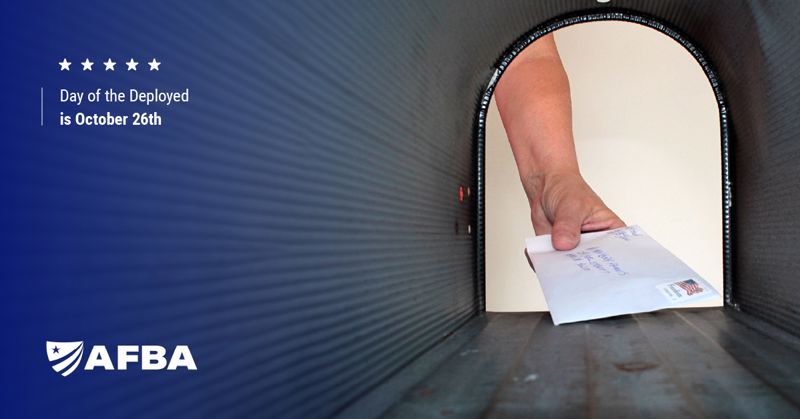
1. Write a letter
One simple way to brighten a soldier's day is to send a thoughtful letter. Even if you don't know them personally, writing a letter to a stranger is sure to lift their spirits, especially when they may be missing home. This small and easy gesture goes a long way in showing your support and spreading love.
2. Send a care package
Speaking of spreading love, nothing shows you care more than a care package — after all, it's in the name! Whether it's clothes, toiletries, snacks or other treats, sending a package of goodies is a surefire way to put a smile on someone's face. Opening up a box of brand-new products from back home is a huge boost to morale, especially when soldiers are deployed overseas in unfamiliar countries.
3. Help a military family
If you know someone who is currently deployed, be a good neighbor and check in with their family. There's a long list of ways you can support them, from offering to help out with repairs around the house to cooking meals or watching their kids. Anything can help take the load off a little — even just listening to them talk about their own challenges.
4. Join a local event
Many communities organize local events, fundraisers and other gatherings on and around the Day of the Deployed to help support our soldiers and their families. Search for one near you to participate in, or, better yet, ask some friends to go with you. These are great opportunities to spread awareness, show your support and give back to the community.
5. Connect with Soldier's Angels
Whether you're having difficulty finding organizations near you or you're interested in the work they're doing, consider connecting with or supporting Soldiers' Angels. Donations are always a welcome option, but with both in-person and virtual volunteering options, anyone is capable of lending a helping hand.
October 8, 2023, was the annual Ms. Veteran America event hosted in Orlando, Florida — a yearly competition meant to honor the service and sacrifice of our women veterans and support our brave sisters who are making the transition back into civilian life and employment.
Not only does the Ms. Veteran America movement encourage and uplift women veterans, but it's also a charity event. All of the proceeds go to Final Salute — a nonprofit organization providing housing for homeless female veterans and their children. With over half of all homeless women veterans being single mothers, this nonprofit organization and the work it does are crucial to supporting our country's military members and families that may otherwise have been left behind.
 The appearance of the U.S. Department of Defense (DoD) visual information does not imply or constitute DoD endorsement.
The appearance of the U.S. Department of Defense (DoD) visual information does not imply or constitute DoD endorsement.In total, Ms. Veteran America has helped:
- Raise $760,000+ for the organization.
- Provide 17,000+ days of transitional housing.
- Secure financial assistance and resources for 7,339 people and counting through Savings Assessment and Financial Education (S.A.F.E.) programming.
- Empower 1,764 people and counting through employment transition with the Next Uniform program.
The event's theme, "The Woman Beyond the Uniform," highlights the strength, resilience and courage of our nation's heroic military women. By providing a platform for women veterans to show off their talents and interests beyond their commitment to our country, the Ms. Veteran America event shines a spotlight on the strength, courage and sacrifice of our nation's military women.
This year's Ms. Veteran America title went to Victoria Taylor, a proud combat camera specialist who served active duty in the Marine Corps for four and a half years.
As the newly crowned Ms. Veteran America 2023, Taylor will continue to play an active role in spreading awareness and advocating for women veterans experiencing homelessness. Through education and empowerment, she'll help her fellow sisters in arms confidently transition from military to civilian life — mentally, emotionally and financially by helping them secure stable employment and housing.
Save the Date For Ms. Veteran America 2024
Did you miss out on this year's Ms. Veteran America event? Not to worry! The next annual competition will take place on October 13, 2024, with more location and ticket details to come.
If you or someone you know are interested in competing in next year's event, consider applying as soon as possible. Early registration will open up in January 2024, with general registration going from March 16 to May 31.
Are you part of an organization that's interested in sponsoring the next Ms. Veteran America? Don't hesitate to get in contact with the event organizers and become a partner.
While next year's contestants prepare for the competition, the work of providing safe, suitable and affordable housing to homeless women veterans doesn't stop. If you're looking for a way to support these heroes and their children, and you have the means, consider donating to Final Salute or getting involved with an event near you.
When an enemy strike occurs, there is little time to prepare. The U.S. must remain prepared in case a strike happens to us or our allies. Many countries look to us for guidance and backup, which means it's our responsibility to keep a favorable posture when it comes to proper Armed Forces funding, training and advancement.
We'll explore how the U.S. is able to remain combat-ready.
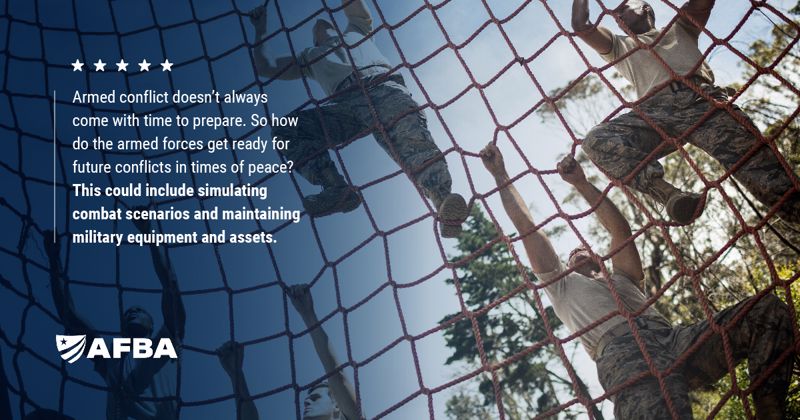
Lying in Wait
The federal government's primary focus is to serve the people of America by protecting our safety and freedoms. There is an official policy highlighted for the Armed Forces called Military Operations Other Than War (MOOTW) for times when there isn't an active need for warfare, combat or threat of violence.
MOOTW is typically used in times of humanitarian aid, engineering, law enforcement, peacekeeping and disaster response. It's used to deter potential aggressors, protect U.S. interests and support the United Nations' (UN) objectives.
Armed Forces planners' prime objective during conflict is to resolve the situation and return to peaceful conditions. During peacetime, the nation can focus on basic objectives rather than defense and attack.
Training
Generally speaking, Armed Forces members who are not engaged in direct conflict spend their days training at either their home station or other locations around the world. Equipment maintenance and research is necessary during these "downtime" periods.
The Armed Forces must go through consistent times of upgrading including their facilities, drills, supplies, equipment and weapons. Success in warfare depends on preparation, so active duty servicemembers drill consistently, even after they understand their duties. This would include knowing where to be at certain times, what gear to grab and why they are there in the first place. There are times when there's no additional leadership during wartime, and soldiers should be ready.
Support
There are some instances where an Armed Forces regime is asked to support citizens in certain areas. This could include:
- Cleaning up and repairing after natural disasters.
- Assisting civil organizations like police and firefighters with heavy equipment.
- Testing new vehicles, weapons and options.
- Observing to prevent suspicious war activity.
- Cleaning up old conflict areas for weapons and debris.
- Acting as standby guard for internal fights, riots or revolts.
- Transporting helpful goods for civilians, such as food and supplies, after times of crisis.
- Blocking actions to prevent crises.
Family
When soldiers aren't actively on base and training, they're experiencing life just like everyone else. They're taking time to build their family, make memories and achieve personal goals one day at a time.
Being on base and in active deployment can take a lot of time and energy away from the other aspects of life. It's important to recover from what happened while on duty, while being present for the life still happening at home.
All in all, members of the Armed Forces live full lives during their career, and the aspects of their duties change along the way.
September — it's the start of fall, the beginning of football season … and also a great time to celebrate the U.S. Air Force. Why? Well, because this branch of the military marks its 76th anniversary this year on September 18. In honor of this date, here are 10 facts about the Air Force and the daring men and women who keep the skies secure.
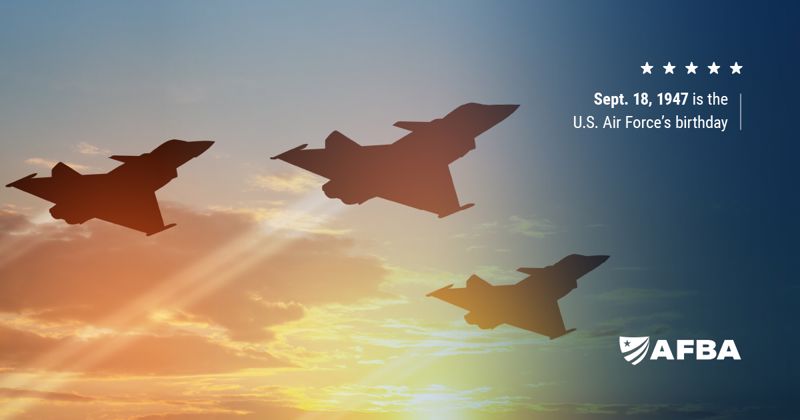
1. The Air Force Used to Be Part of the Army
The Air Force celebrated its 75th anniversary in 2022 — but that doesn't commemorate the day the first American aviators took to the sky. Rather, on that day in September 1947, the Air Force and Air Force Command were spun off from the Army, which had been in charge of airborne operations through both World Wars.
2. There Are 17 Air Force Bands
The Air Force Band is one of the premier military ensembles — but "one" is the wrong term. There are two main groups, joined by nine active duty bands, five in the National Guard and one deployed in Southwest Asia. These musicians are heard by six million people a year.
3. Air Force Planes Help Fight Wildfires
When wildfires recently struck California, the Air Force got the call to help with the firefighting effort. Specialized C-130 planes flew 156 missions to battle the blazes in just a single month.
4. NORAD Coordinates Air Defense — And Tracks Santa
The North American Aerospace Defense Command (NORAD) is an organization combining U.S. and Canadian air and space defense units. Among other things, it annually runs a popular site that lets kids bring up Saint Nick on the radar as he circles the globe.
5. Women Make Up Over One-Fifth of Air Force Members
The latest data shows that 21.4% of Air Force personnel are women. The service has trained female pilots since 1976, navigators since 1977 and fighter pilots since 1993. Among officers, this figure rises to 23.3% of personnel.
6. The Air Force Academy is the No. 2 Source of Astronauts
Can Air Force training get people ready to go to space? Historically, the answer has been yes. The Air Force Academy has produced 39 astronauts, making it second only to the Naval Academy.
7. "Sully" Had Air Force Training
Commercial Airline Pilot Chesley "Sully" Sullenberger became famous for successfully landing his damaged jet on the Hudson River and saving over 150 passengers' lives. What you may not know is that he's an Air Force Academy graduate from the class of 1973.
8. 17 Air Force Football Players Have Gone Pro
The Air Force Academy's football team, the Falcons, have sent 17 players into the pro ranks, with the most recent being Detroit Lions tight end Garrett Griffin.
9. The Air Force Has a Grateful Dead Connection
Psychedelic rock and the U.S. military don't seem like obvious bedfellows, but in addition to astronauts, aviators and football players, the Air Force produced a member of the Grateful Dead. Keyboardist Tom Constanten played with the Dead from 1968-1970 directly after a stint in the Air Force.
10. The Air Force Museum Has Over 350 Vehicles and Missiles
The Air Force maintains a comprehensive museum on the grounds of Wright-Patterson Air Force Base in Ohio. The facility is the oldest military aviation museum in the world, and also the biggest, spanning 19 acres. All that space is necessary to hold the hundreds of pieces of decommissioned hardware on display.
Now you have 10 facts to share about the Air Force as the branch celebrates its 76th year this September. From early flying aces to astronauts exploring the cosmos, Air Force personnel have worn many hats over the years, and their mission is still evolving today.
Every year since 1979, the third Friday of September has been designated as POW/MIA Recognition Day. It serves to honor two groups of service members — those who were held prisoners of war and returned, and those still unaccounted for.
As of now, the Department of Defense knows of over 81,500 missing personnel from conflicts dating from World War II to the present. POW/MIA Recognition Day provides an annual reminder to remember these brave service members and to become better educated on the efforts to account for those whose fate is still unknown.
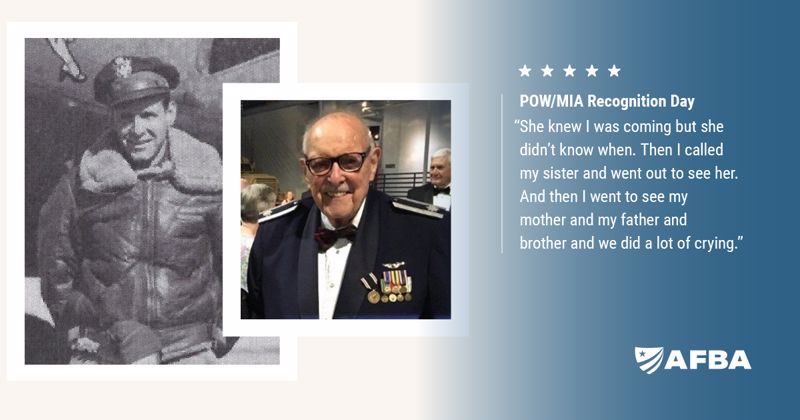
The Mission of POW/MIA Recognition Day
President Jimmy Carter designated the first POW/MIA Recognition Day, and ever since, the event has been commemorated with ceremonies at military installations around the world. A recurring feature of this day is a presidential proclamation in which the commander in chief reaffirms the country's commitment to the individuals still missing in action.
The messages offered by presidents, including Joe Biden's 2022 proclamation, reaffirm that the work of identifying and recovering the missing is still ongoing. This September 15 is a good moment to reflect on this effort and the progress being made to give clarity and closure to the families of these service members.
In June of this year, around the unveiling of the official poster for POW/MIA Recognition Day 2023, the Defense POW/MIA Accounting Agency (DPAA) gave an update on its efforts. Over the course of the fiscal year, the group accounted for 81 individuals.
Those efforts from the DPAA involve cooperation with other governments — 45 in all — and include tracing the locations of MIA individuals as well as the repatriation of remains.
The Quest to Locate Missing Service Members
Looking at the numbers, it quickly becomes apparent just how big the task is facing the DPAA. Of the over 81,000 Americans still unaccounted for, over 41,000 are presumed lost at sea due to the loss of ships or aircraft. It can be costly and demanding work to trace the locations of these MIA personnel, but the efforts are ongoing nevertheless.
The Department of Defense offers a look at all the steps necessary to identify and repatriate a lost service member. First, officials in the DPAA analyze and investigate reports of unaccounted for Americans, creating separate case files for each. In cases where relatives of an unidentified service member are available to give DNA samples, officials can disinter remains to determine whether their research has led them to the missing person's final resting place.
Investigation follows, interviewing witnesses and examining the site. If this evidence supports excavation, the site is dug up and the remains recovered. Over the next months or even years, the DPAA performs tests, inspecting historical records, using DNA analysis and conducting forensic studies to determine whether they can conclusively attach an identity to remains. If they can, the identified American is returned home to surviving family members.
Resources for Family of the Missing
The DPAA offers publications and interactive guides that may bring families closer to identifying and locating their unaccounted for loved ones. A fact file explains the process of recovery, from initial planning to arranging a memorial, an interactive guide profiles those still missing and a separate database lists those who have recently been identified.
POW/MIA Recognition Day is a perfect opportunity to check these resources and become more aware of those who have served their country and are still unaccounted for. On this day and all year round, it's important to remember the sacrifices these brave individuals made.
Whether it's a Military ball or another formal event for the Armed Forces, these scenarios can add up after a while. That's why Operation Deploy Your Dress (ODYD) was developed. It's a chance for women of the Armed Forces to look their best at any formal affair, without the costs that come with it.
We'll explore more about this organization and how you can get involved.
Meet: Yvonne Coombes
Yvonne started as a Navy Family Readiness Group Leader from 2005 to 2007. This means that she represented a group of people who supported other spouses of those in the Armed Forces during deployment. This role helps directly connect commanders with their community, even during deployment.
From there, Yvonne continued to facilitate communication, community and commonplace between those on deployment and their family and friends. From helping with CrossCountry Mortgage to what is now the ODYD, Yvonne is dedicated to helping Armed Forces families get the support they need to lead the lives they want.
She truly believes that everyone who serves should feel the "tradition and camaraderie that takes place at military balls and formal functions."
Yvonne has been a Military wife for 20 years, and has helped hundreds of families connect and feel taken care of around the world.
What is ODYD?
Military balls are a significant part of the culture in this sector. Yvonne is the cofounder of ODYD, and began this journey in 2015 when she and her friends did a dress swap among the other women within their unit and their spouses. The intention was — and remains — to offset the cost of attending formal Military affairs.
They decided to expand this idea on a national and international level. Yvonne and her friends opened up these swaps to other units, which helped them gain more media attention. In the past 8 years, they have opened 13 stores around the country, with one in Germany that "deploys" dresses to any Military ID holders.
Their line of dresses includes a full bridal department where brides-to-be can pick from 27 brand-new wedding gown styles, accessories and looks. The entire process is done online through video conferencing so that any bride can work with the ODYD Bridal team so they're matched with the perfect dress.
Their newest installation occurred in 2022, with a partnership with David's Bridal. David's Bridal launched the Frontline Fierce Corporate Philanthropy Initiative to support frontline workers with formal dresses.
Fittings and Volunteers
The organization is run entirely by volunteers, donations and pure partnerships. They found support through the Fort Bliss Garrison Command and the Spouses' Club, which helped them expand their offerings and locations.
A Military cardholder can come by any one of the shops or contact the team online to pick up one dress and one accessory a year.
Being part of the Armed Forces or a spouse of someone serving isn't easy, but organizations like ODYD and their partners work hard to support in any way they can. You can make a donation or become a volunteer online by contacting them today.
Is life insurance the most overlooked, misunderstood and underrated kind of insurance? It may just be, specifically because it's so hard to envision needing this kind of coverage. It's uncomfortable to consider needing life insurance, and if you're young and in great health, it can seem like such a remote prospect, you might simply ignore it.
But that kind of attitude, while understandable, leaves people without the coverage they need. Only 53% of men in the U.S. have life coverage, and even fewer women — just 46%. This is why the insurance sector has come together to declare September Life Insurance Awareness Month. It's the time of year to take some of the fear and mystery out of life insurance and see it for what it is: An important and affordable way to look out for your loved ones.
What Is Life Insurance and Why Do You Need It?
Simply put, a life insurance policy exists to ensure that if the holder passes away, their nearest and dearest will receive financial support. It's a way to help families get by in extremely hard circumstances — and considering just how vital this can be, the costs are low.
In some cases, it's clear why and how that money matters. If you're married, it will help your spouse. If you have children, it can go to their care. But what if you're single and childless? Life insurance still matters, and it was cases like this that Life Insurance Awareness Month was founded to address.
There are so many instances when extra funds could help the people and things you care about most. If you own your own company or have anyone financially dependent on you in any way, money may matter a great deal. You provide for the individuals in your life and look after them every day. It can be comforting to know you could do the same in your absence.
Costs simply add up. Family members will have to go grocery shopping every week. Any kind of business will need money to keep the doors open and the lights on. Life insurance helps these things keep going — it's a way to show you're watching out for all the pieces of your life, and it's typically not hard or overly expensive to get a policy.
How Do You Get Life Insurance — and Pick the Best Plan?
How much coverage do you need to provide for your loved ones? That depends, but you can narrow it down. For example, Life Happens, the same group responsible for Life Insurance Awareness Month, offers a calculator. Plug your information into this system and you'll figure out the best policy amount for your needs. Then it's time to choose a provider.
Finding a life insurance policy doesn't have to be complicated, but you should take the decision seriously. This might mean working with an insurance agent or broker. That could mean choosing an independent professional to compare companies' offerings or working directly with a provider's agent.
Every provider offers a slightly different selection of products, along with a unique experience for policyholders, and a broker could help you sort through the offerings. Policies may also be available through employers, but there are some complexities that come with certain professions.
This is a good time for a history lesson. In 1947, U.S. service members weren't able to find coverage that would pay a death benefit if they lost their lives in combat. This is the reason why AFBA was founded — to provide peace of mind to the people who were serving their country. That's what we're still doing today, offering benefits to active duty military members, veterans and first responders.
When summer hits, the kids are off, your spouse’s PTO is saved up and the promise of a fun adventure is on the horizon. A trip to Washington DC could serve to be a rewarding experience for the whole family. Not only do you get to feel the heartbeat of America, but you can also dive into its deep history.
Before booking your trip, here’s what you need to know and some spots to put on your itinerary.
Planning your trip
DC has a lot to offer the common traveler. From the White House and Capitol to the presidential and military memorials. With so many attractions and potentially not a lot of time to see them, it’s important to narrow your choices and focus on a specific aspect of the city. Let’s get down to how to plan your trip.
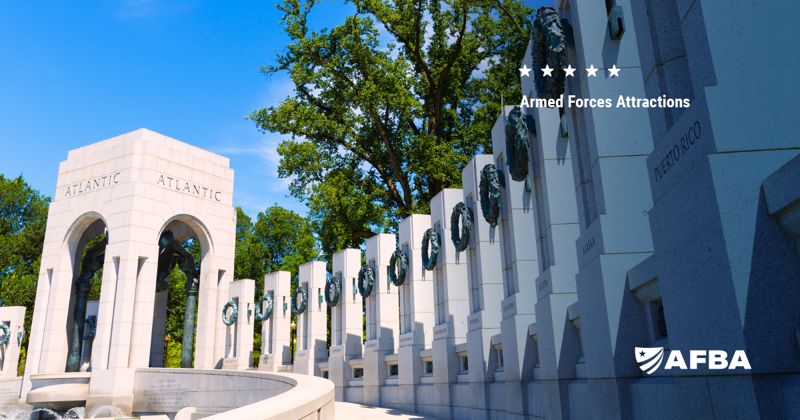 “The appearance of the U.S. Department of Defense (DoD) visual information does not imply or constitute DoD endorsement.”
“The appearance of the U.S. Department of Defense (DoD) visual information does not imply or constitute DoD endorsement.”AFBA travel benefits
If you’re an AFBA member, you have certain travel benefits you should take advantage of before booking anything.
- Car rental discounts: While DC is notoriously easy to walk through and shared rides are abundant, you may consider booking a car rental. This can be helpful if you want to stay somewhere outside the city and visit surrounding sites, want to make DC more accessible on your own time or have specific travel needs like wheelchair access.
- Armed Forces vacation club: From hotels to exclusive discounts, any member of AFBA can benefit from starting their itinerary with this one-stop-shop website.
- Wholesale hotel rates: Receive wholesale rates at over 600,000 hotels around the country — that’s 60% of any hotel on the list!
All of these advantages can put your trip on the right foot.
What to bring and not bring
Traveling comes with it a host of decisions, but here’s what to bring and leave behind on your trip.
Summer in DC is known for its humidity and average temperatures falling between the high 80s and low 90s. These two weather conditions combined make for summer storms as well. So, pack your raincoat, a good pair of walking shoes and your favorite breezy summer clothes to make this trip the best one yet.
DC is also a fairly large city, and it could get confusing if you’re not familiar with the area. Map out where each site and attraction is beforehand so you’re not wasting your time zig-zagging across town. If you book a tour, be sure to mark where the guide will meet you.
The top museums and locations to visit
Along with the main attractions like the National Mall and the Lincoln Memorial, here are the best places to see if you’re a military history enthusiast:
- The Korean War Veterans Memorial.
- National World War II Memorial.
- Smithsonian National Museum of American History.
- National Museum of the United States Army.
- Vietnam Veterans Memorial.
- National Museum of the United States Navy.
There is a lot to do and see when you visit Washington DC. Once you have your itinerary planned out, enjoy the music, food, art and culture of the area.
Virtually everyone has used insurance at least once. It comes in a wide range of forms covering practically everything, from life and auto insurance to protection for parcels in the mail. You can even insure items like your watch or smartphone against being lost or stolen. The list may genuinely be endless.
If it can be insured, someone probably offers coverage for it. But do you regularly compare your insurance needs with the insurance you own? Are you getting what you need at the right price?
Do you need life insurance when you’re young (you do) or should you wait until you’re older? How likely do you think you are to be in an auto accident? Are you covered if you become ill or injured and need an emergency room visit or hospitalization?
Depending on the answers to questions like these, you may wish to alter your insurance plans. That’s what National Insurance Awareness Day — observed on June 28 every year — is for.
Insurance has been available for thousands of years
Some of the earliest civilizations had insurance. Somewhere between 4000 and 3000 BCE, Babylonian sea merchants would purchase bottomry contracts. These had a ship’s owner use their vessel as collateral in exchange for a loan including interest. If the ship was lost at sea or heavily damaged, the insurer would be out of luck; but if the ship returned safely in good condition, the loan and its interest would be repaid.
Marine insurance continued to develop in new forms across the world, including in ancient Greece and those who traded with them. The Romans, while they were busy revolutionizing civilization, invented life insurance.
In the 17th century, the famous and still-existing Lloyd’s of London was founded. Its founder, Edward Lloyd, would gather information about shipments from docks and compile them into the Lloyd’s List publication. While its information-gathering is a little more sophisticated than when it began, Lloyd’s List is still being updated today.
 “The appearance of the U.S. Department of Defense (DoD) visual information does not imply or constitute DoD endorsement.”
“The appearance of the U.S. Department of Defense (DoD) visual information does not imply or constitute DoD endorsement.”Why evaluate your insurance needs?
First, consider what you want to be insured. Medical bills and your automobile are some of the most popular options. Other types such as life insurance are all too often passed over.
Even if you have all the insurance you need, you may be paying too much. Rates are constantly changing, and it’s worth the time and effort to shop around for the best price.
If your life circumstances change, so should your insurance. Have you taken a new job that requires driving in dense traffic? Has your health changed? What about your marital status? Many life events warrant taking a fresh look at your insurance options.
You don’t necessarily need to shop for a new insurance provider and go through the paperwork all over again. You can talk to your current company and ask if they have other choices or promotions that might better suit your life situation. Many insurance companies allow you to customize your plan online.
Seeking out other ways to lower your insurance costs is something else to consider. Have you purchased a new car with advanced safety features? Bring it up with your auto insurance company. Are you taking care of yourself better? Maybe hitting the gym more, eating well and better controlling your weight? You could be eligible for health insurance discounts.
Look at your insurance options on National Insurance Awareness Day
It’s strongly recommended that you take the time annually to look at all your insurance options and find the best policies and rates that fit your specific needs.
Perhaps the most important thing you get from insurance is peace of mind. Knowing you’re covered in the event of an incident makes you feel better with less stress and worry — which can mean a longer lifespan and better overall health.
